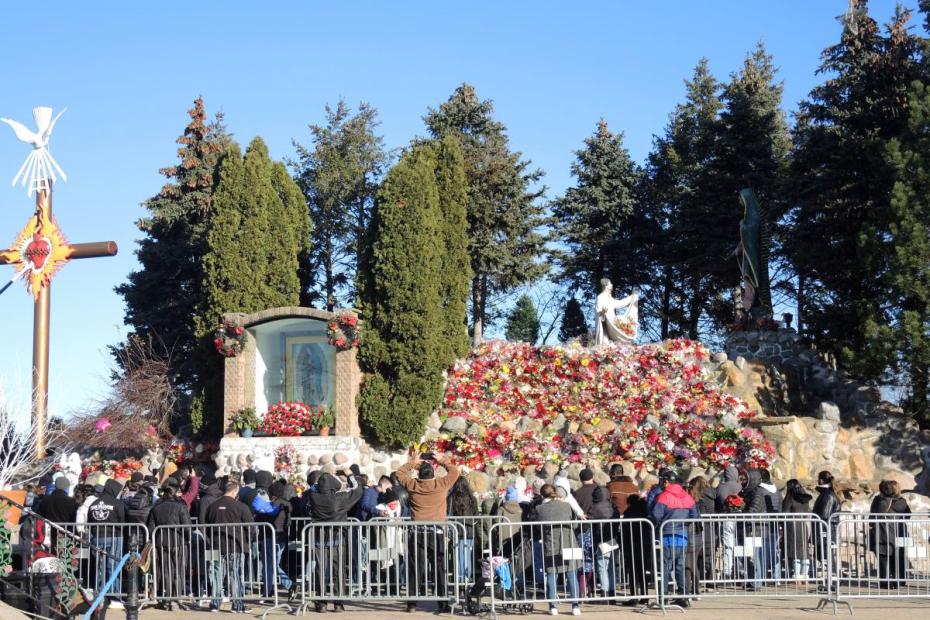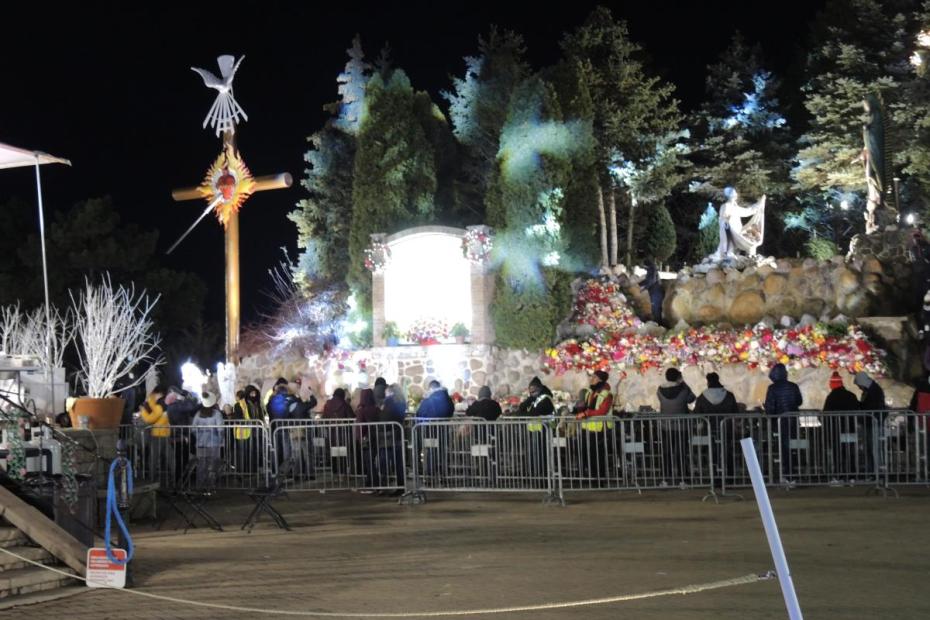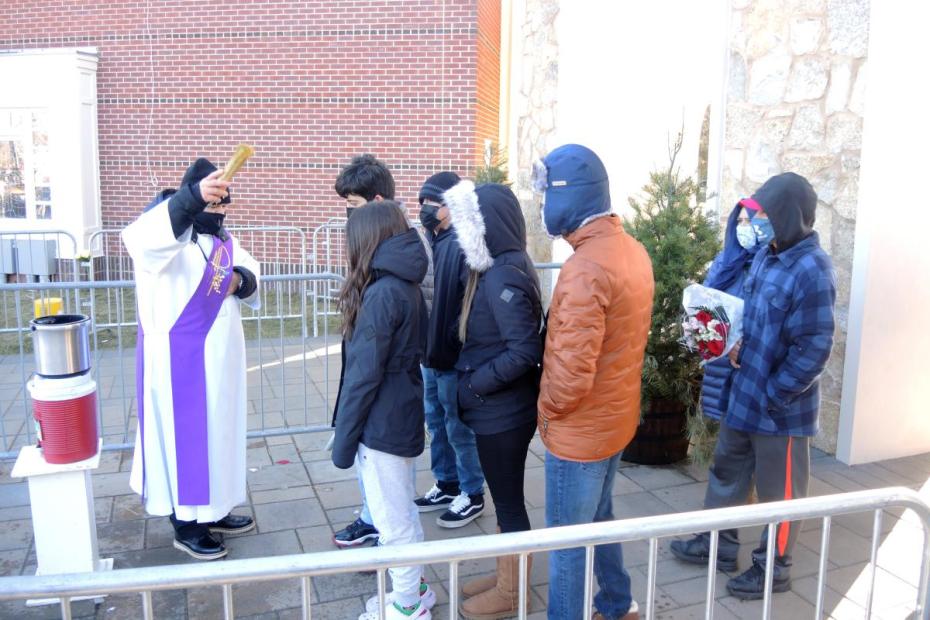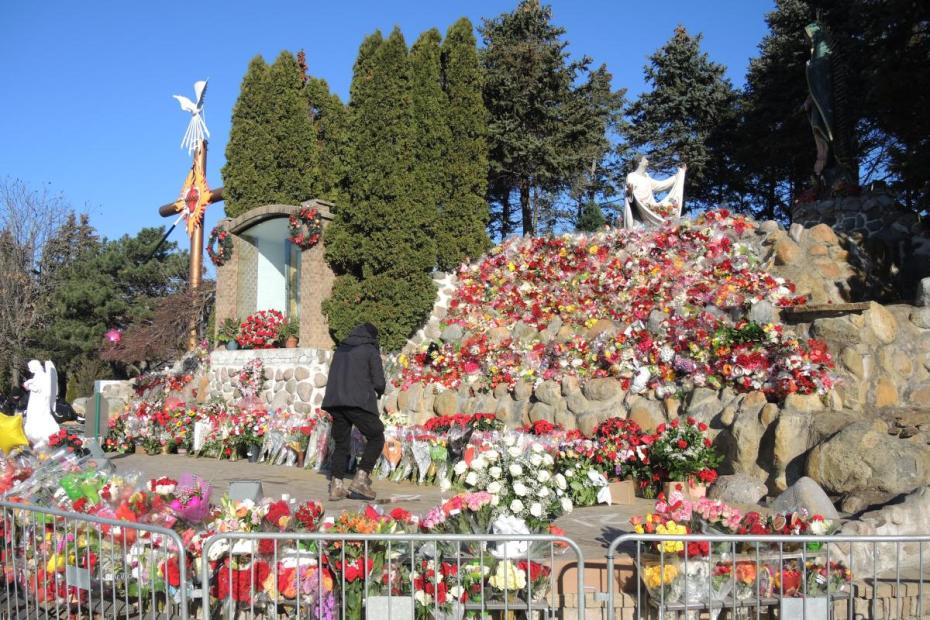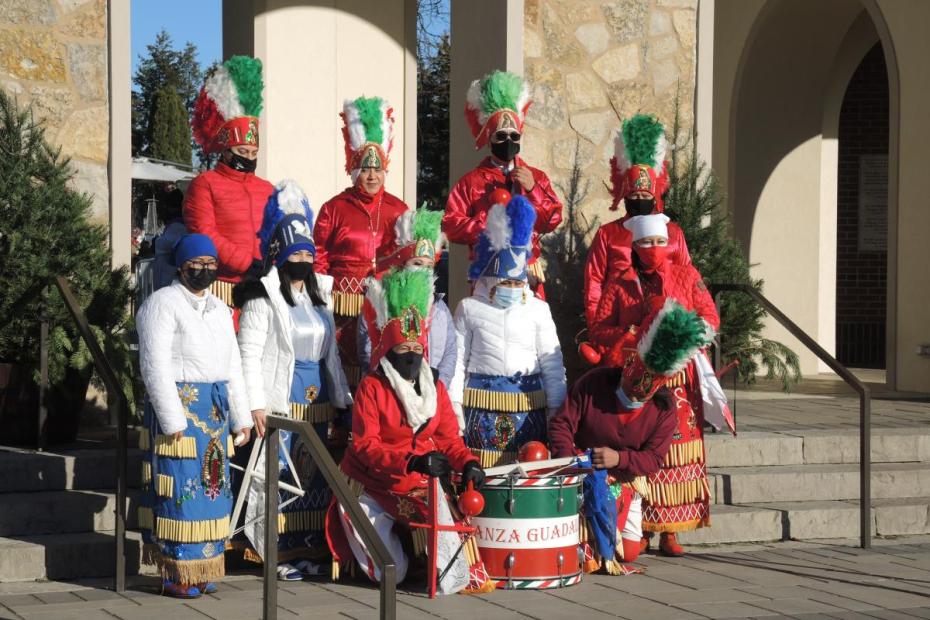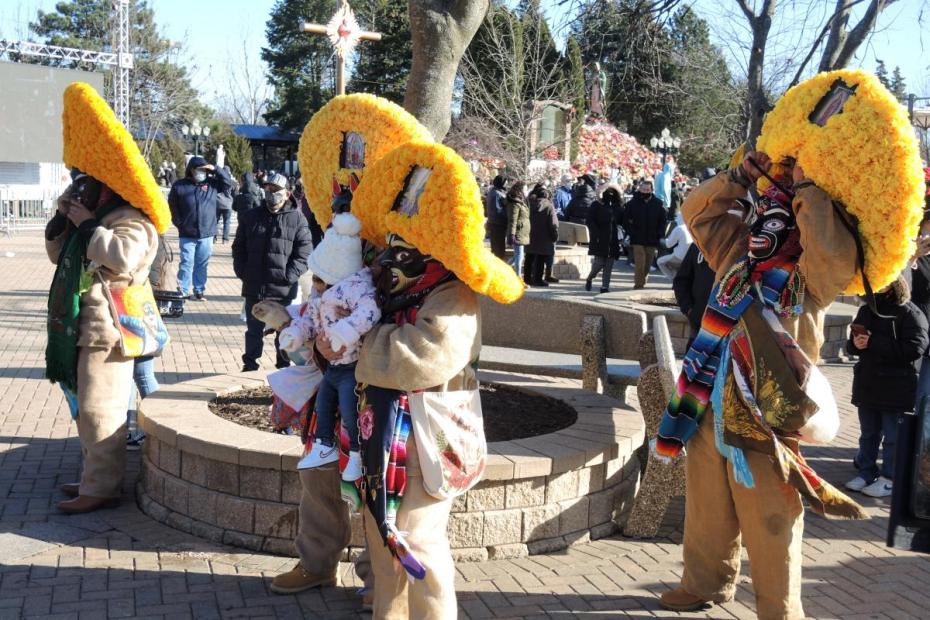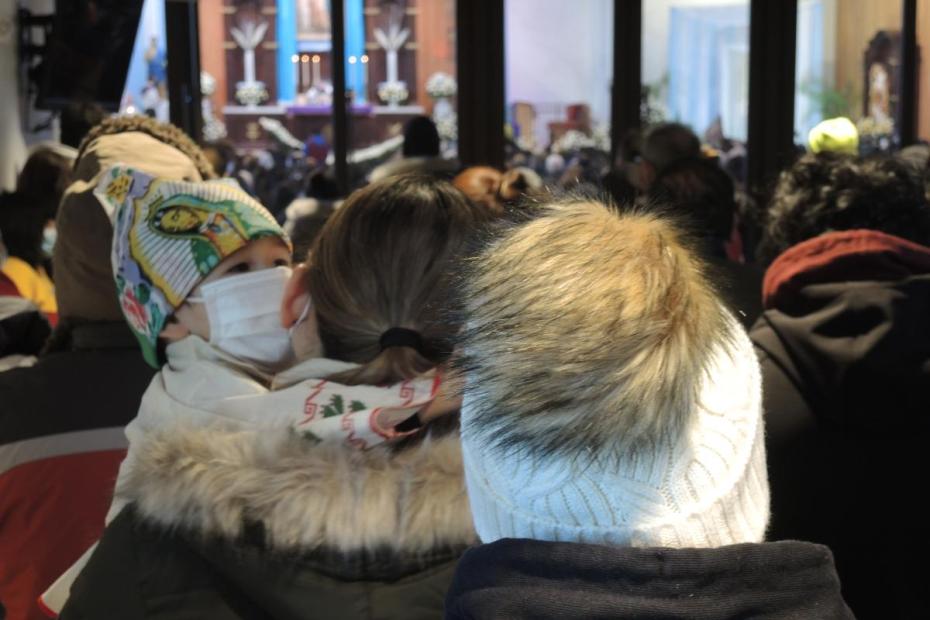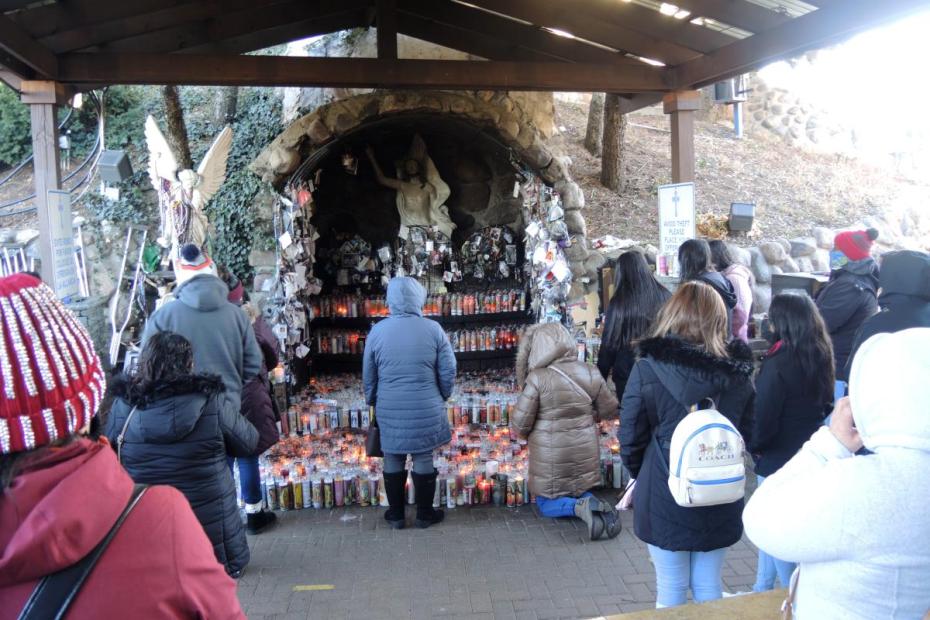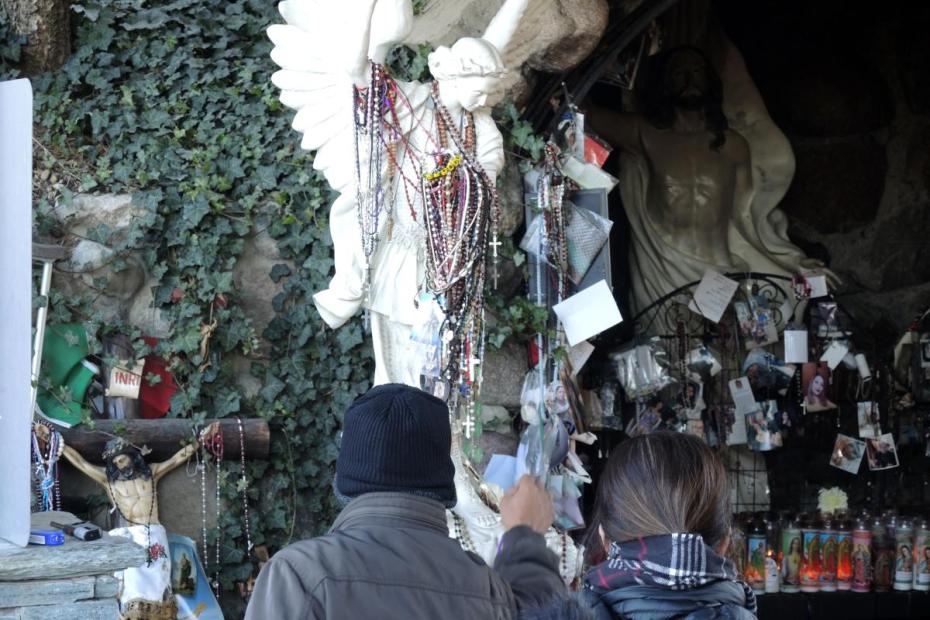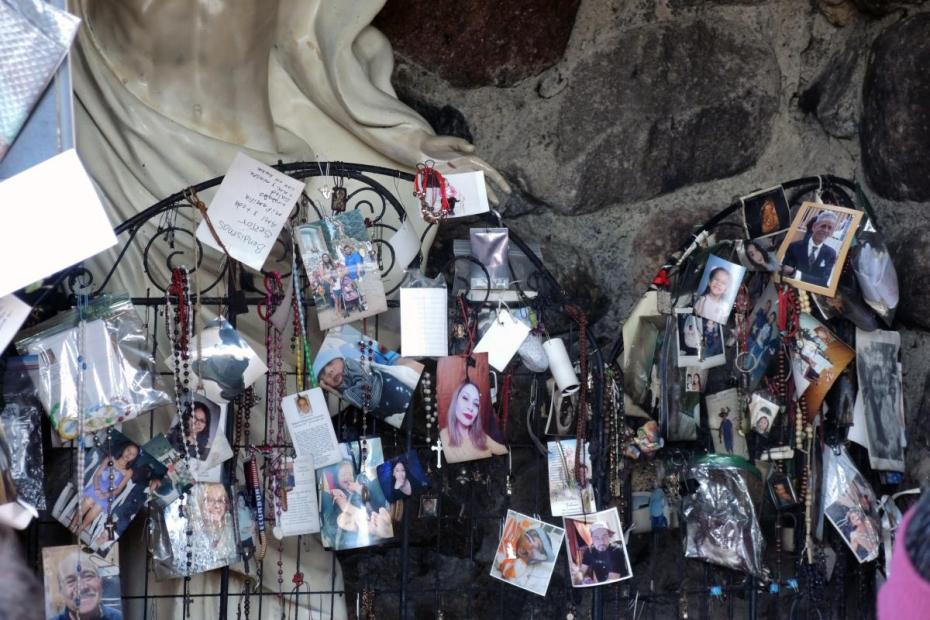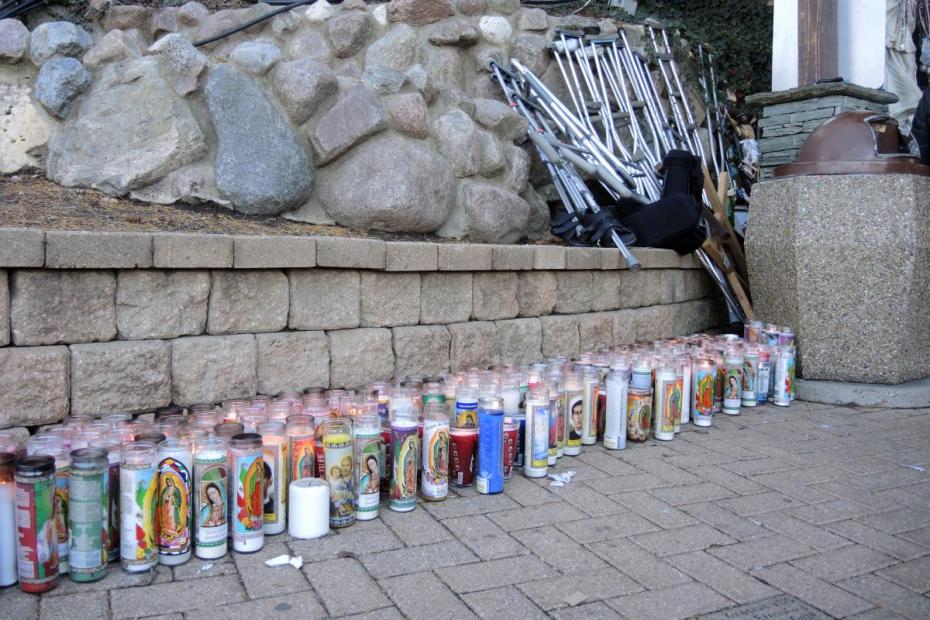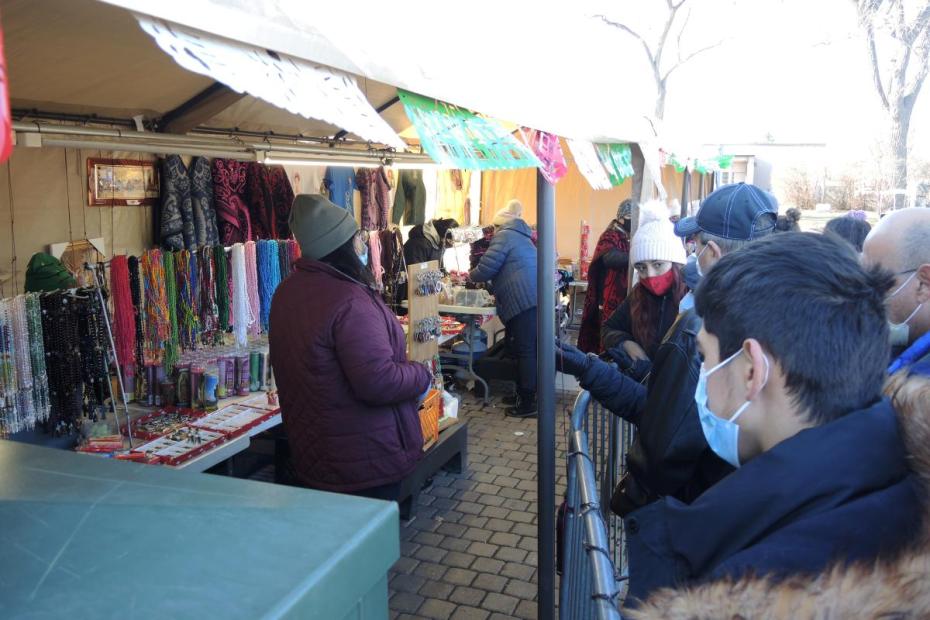In the northwestern suburbs outside Chicago, on a large property bordered by a cemetery and housing tracts, crowds sometimes exceeding 200,000 have been gathering for decades on freezing December nights in the city of Des Plaines to honor the feast of the Virgin of Guadalupe in a manner that echoes the great feast in Mexico City.
Just as it was once deemed to be surprising that a hill outside Mexico City would be the site for the appearance of the Virgin and that she would have appeared as a brown-skinned Nahuatl speaker, so too might it seem surprising that an unassuming 62-acre prairie land property, the longtime site of a Church-sponsored children’s services agency, would host what is likely the largest annual gathering of Catholics in the United States, a Mexican-associated feast at that. With few (though interesting) exceptions, organized public, outdoor feasts are relegated to pre-Vatican II memory in much of the United States, where the great majority of Catholics never experience one personally. But Chicago’s Mexican-American community has been growing for decades, and its members created a very public way, in a new place, to honor La Virgencita.
In December 2021, following many months of COVID-19 church closures and the cancellation of the 2020 feast, masked worshippers gathered again, their numbers peaking during the night of December 11-12.
Historical background
Public devotion to Our Lady of Guadalupe is a centuries-long tradition in Mexico City, born out of an account of an apparition to Juan Diego Cuauhtlatoatzin on Tepeyac hill in 1531. Her December 12 feast was declared in 1754. During the ten days leading up to the feast eight to ten million people a year trek to Tepeyac and the basilica below it where her famous tilma, or ayate, image hangs above the altar. Millions more in Mexican and Mexican expatriate communities honor her in their daily lives, by prayers and by images that are visible everywhere from shops to living rooms to tattoos.
Mexican-Americans are one of the many immigrant peoples who defined Chicago as a patchwork of ethnic neighborhoods in the 20th century.1 Their numbers grew significantly in recent decades, in Chicago, the suburbs and in rural areas of the state. Chicago’s first Mexican parish, Our Lady of Guadalupe, dates to 1924.
The impetus for the shrine in Des Plaines came from a layman and a community of Guadalupanas who built up a devotional movement first centered in various homes and parishes before they also grounded in an unlikely suburban spot.2 In 1987, Joaquín Martínez, a Chicagoan, brought a statue from the Basilica of Our Lady of Guadalupe in Mexico and started a group to encourage devotion to her. The priest-president of Maryville Academy, a children’s services agency, offered the community space on the property and played an integral role in the development of the shrine. In 1996-7 a large copy of the famous image of Guadalupe was brought from Mexico to be placed on display, and the cerrito, a miniature hill topped with statues of Our Lady of Guadalupe appearing to Juan Diego Cuauhtlatoatzin, was built up behind it. The property was blessed and sanctioned by the rector of Mexico’s Basilica of Guadalupe, who even brought soil from the original Tepeyac to mix into the new hill. He formally sanctioned the Des Plaines shrine as a place to visit to fulfill mandas, promises to the Virgin of Guadalupe, something that often previously occasioned a visit to the Mexican shrine.
The shrine at Des Plaines
The shrine’s facilities are fairly modest, though they continue to be expanded. The centerpiece, the cerrito, is a mini, man-made hill symbolizing Tepeyac, the hill in Mexico City where Juan Diego reported apparitions of the Virgin. At the top right of the hill are larger-than-life statues of the Virgin of Guadalupe appearing to a kneeling San Juan Diego Cuauhtlatoatzin, his tilma overflowing with flowers. At the center front of the hill, flanked by arborvitae trees, is a glass-enclosed replica of the famous tilma image of Guadalupe that draws so many pilgrims to Mexico City’s basilica. To its left, the largest, tallest image of all is a Cruz del Apostolado (the Cross of the Apostolate), a cross with a dove descending upon it, and in place of a corpus, an image of the Sacred Heart at its center, pierced with a large lance.3 Large and visible as the cross is, the images of the Virgin are the focus of attention.
In front of the hill and the tilma image, a plaza had been fitted for the feast with a raised gazebo-altar for outdoor Masses. The shrine had recently been augmented with arched stone portals to serve as a gateway, through which all those who wish to pass in front of the statue enter and, during the feast, are blessed by a deacon. Next to the gateway is a religious goods store and some offices. On the lawn in front of the gates is a huge enclosed tent where tamales and hot chocolate and other beverages are available, raffle tickets are sold, and in 2021, COVID-19 vaccines were available as well.4
Celebrating the feast
The shrine is open year-round for visits, Masses and other sacraments, and even for traditional Mexican religious events like presentations of three-year-olds and Quince Años celebrations. But the feast days are a special draw.
As at Mexico’s basilica, the celebration starts a full week before. In Des Plaines, the 2021 celebration began with a cavalcade of more than a thousand horseback riders who passed slowly in front of the image to pay their respects. Dozens of tractor-trailer drivers also brought Guadalupe-decorated rigs to be blessed.
The activity ramped up on December 11 and 12, and through the night in between. The crowd was never huge, but was constant, with 50-100 people at any time waiting in line for a brief visit in front of the cerrito. Others promenaded quietly around the grounds in small groups or visited the huge–fortunately, warmer–food tent. Fences were set up from the entrance to the cerrito to funnel those who wanted to pass in front, ensuring that all visitors to the foot of the shrine would be first greeted and blessed by a deacon. As in Mexico, most people came simply to pay their respects and pass before her, to make or fulfill a manda–a visit made in fulfillment of a prayer request. Most really got only a few moments, no longer than a minute if they tried to stand back to let others pass.
Many families brought bunches of flowers to leave as an offering on the cerrito below the statues of Guadalupe and San Juan Diego. Flowers are significant in the Guadalupe story. The Virgin’s gift of flowers to Juan Diego at Tepeyac in December, when they don’t grow there, was regarded both as a miraculous sign of affirmation that it was she who had appeared, and as a sign of her generosity. Today, believers bring flowers to adorn this little Tepeyac and honor Guadalupe herself. By morning on December 12, the area in front of the statues was covered almost completely with flowers brought by pilgrims, many of them during the night.
An opening Mass in the plaza launched the feast at 7 p.m. on December 11 for a crowd of perhaps a thousand worshippers. The Mass, in English and Spanish, included traditional songs to Guadalupe and calls of Viva la Virgen! As the Mass continued and the temperature dropped to freezing, more people made their way in. After more singing, a fireworks spectacle affirmed the specialness of the evening, as devotees continued to come to the grounds. At 11 p.m., devotees joined in singing Las Mañanitas, a serenade sung not only to awaken a person on his or her birthday but also famously sung at the basilica at midnight on Guadalupe’s feast.
There was another Mass at midnight, and a Rosary afterward. The morning opened with another Rosary, another Mañanitas, and was marked by five more Masses and Rosaries, the last of which included a reenactment of the apparitions. The Masses were crowded, but given the size of the chapel and the total number of attendees claimed, it could easily be the case that one in ten pilgrims–or fewer–attended a Mass. Devotees lingered around the property; the pace was never rushed. A little prayer grotto built into the side of the hill provided one more place to pray, and many others took time just to walk around in small groups and take the whole experience in.
Mirroring Mexico, but also adapting to a U.S. context
The devotion at Des Plaines borrows a great deal from the celebration at Mexico City’s Tepeyac, from the cerrito and the images on it to the flower offerings, the Mañanitas, music at Masses and occasional cries of Viva la Virgen! Concheros even danced in the plaza from time to time.
Beyond the obvious differences in scale and grandeur, though, the experience at Des Plaines was different from Tepeyac in notable ways. This was true not because there were large numbers of Anglos to accommodate. All but about twenty people I saw were Mexican or Central American by birth or heritage.5 Still, many of the liturgies in Des Plaines were bilingual, because, one presiding bishop explained, they were aiming to welcome younger generations born in the USA and whose prayer may be in English.
In contrast to the huge, kilometer-long foot procession of pilgrims taking up the whole of the boulevard to the entrance of the Mexican basilica–most of whom may have walked or traveled for days to reach that point–in Des Plaines, in true American style, most visitors arrived by car, usually traveling for a shorter time, though they spent time instead sitting in a kilometer-long traffic backup waiting to enter the grounds.6
Occasional small groups of pilgrims walked long distances via Highway 45, even late at night, but they were the exception.
Perhaps because people traveled in individual cars, the groups of visitors were smaller than in Mexico City. That said, aside from the volunteers, no one was ever there alone.7
Most traveled as families rather than as large parish or multifamily groups.8
The experience of prayer, though personal, was mediated through family accompaniment, whereas at Tepeyac it seemed to be mediated through family accompaniment and that of a larger group of friend devotees they traveled with. What stands out in an American context was that “we” was much more commonly used to explain attendance and devotion than “I.”
Though anyone who had not been to both Tepeyac and Des Plaines might not notice, the most significant differences may have been in terms of how people comported themselves at each place, and in differences in the visible materiality of their devotion. The shrine in Des Plaines is noticeably more placid than the shrine in Mexico City. Whereas the latter is generally full of activity and motion and thunderously loud from the noise of the dancing and drumming in the plaza and people speaking in the basilica as they waited in line, the shrine in Des Plaines was remarkably hushed. Even the sound of music playing or Rosary recitation over the speakers, or the shouts of Viva! were more restrained than in Mexico City. Occasional groups of Concheros dancers did dance at Des Plaines, but even this was restrained by basilica standards. The hustle and bustle and occasional exuberance at Tepeyac were replaced by more hushed, interiorized forms of religious expression that might be seen as an adaptation to U.S. norms for piety.
Despite the presence of a religious goods store selling many very large statues like those one might commonly see carried by pilgrims at Tepeyac, devotees at the Des Plaines shrine carried far fewer statues or images for blessing than in Mexico City, where a pilgrim might carry his family’s statue or framed picture the whole distance from home to the shrine, or buy one there to bring home. Flowers and to a lesser extent devotional candles were the primary visible objects brought to express devotion. That said, many visitors to a booth behind the bookstore were buying smaller, more discreet religious goods like rosaries and medals. The embrace of devotional objects may not have been fully diminished in America, but seemingly is miniaturized and relatively privatized.
Creating bonds
Scholars have long noted the extraordinarily multifaceted ways that Guadalupe has been regarded by those devoted to her. Short conversations in the bitter cold of the feast cannot do justice to that full range of representations.9 But some things could be heard, seen and recounted.
A number of people at the Des Plaines shrine made clear that they had come to ask for La Virgen’s help. “She is our protector,” said one woman. A young man simply said, “We come here to ask for a better life.” Certainly, many people were at Des Plaines to make a request, but the quality of devotion extended beyond patronage to something essentially relational. The goal certainly seems to be to appeal to her power to look over them and prevent harm, but equally is about a certain intimacy, a desire to simply be close to her. “She is our mother,” one woman said. Being here is “a way to show that you love her.” Even people fulfilling a manda, which can sound transactional, framed it as being about showing love and gratitude.
Bonds of intimacy were often visibly mirrored in the families walking the grounds. Some people hinted that they were there not so much to make requests themselves but to be with and support someone for whom it was particularly important. Notably, children and young adults were often physically close to women who appeared to be their mothers, holding them by the arm, or leaning a head on their shoulder.
In Mexico City, the pilgrimage to the basilica surely has a formative, catechetical effect on young people, but here too it has an added effect, insofar as visitors fear that their children could otherwise lose this attachment to the Virgin in a new land. Whatever the similarities and differences between Tepeyac and Des Plaines, many of the devotees in Des Plaines will never be able to visit the original location in Mexico City, and to some degree, this “second Tepeyac” provided a bond with the original place.
The shrine’s place in American Catholic life
The sheer number of people who take the time to visit the feast of Our Lady of Guadalupe at Des Plaines is a sign of the ways that recent waves of immigrants, particularly Latinos, are changing the face of American Catholicism and providing it with new vibrancy.
Despite the welcoming environment created by the organizers, coverage about the feast in local media, and the bilingual format, it was still striking to see that “Anglo” Catholics were rare at the cerrito on the feast. The shrine’s history makes clear that it exists because of collaborations between Mexican Americans and Anglo Church leaders. The feast is a living sign of the dedication of Mexican American Catholics, among others, and is not diminished by the lack of others’ participation, but for broader context it bears noting that the makeup of the attendees strongly suggests that American Catholics from other ethnic backgounds still haven’t taken up this devotion as “theirs.” American Catholicism is still something of a patchwork, and this–even if it is the largest event of its kind in the United States–is a “Mexican” event that other American Catholics have yet to explore and participate in deeply.
Read more:
Elaine A. Peña, Performing Piety: Making Space Sacred with the Virgin of Guadalupe (University of California Press, 2011).
- 1For an accessible, concise history of Mexican presence in Chicago, see “Mexicans” in Encyclopedia of Chicago, http://www.encyclopedia.chicagohistory.org/pages/824.html.
- 2This account derives primarily from the shrine’s account of its own history, and also from that recounted by Elaine Peña in “Beyond Mexico: Guadalupan Sacred Space Production and Mobilization in a Chicago Suburb,” American Quarterly 60, no. 3 (2008): 721-47.
- 3Blessed Concepción (Conchita) Cabrera, a Mexican laywoman, claimed an apparition of this cross in 1894. The image is associated with two religious orders that sprung from her inspiration, the Missionaries of the Holy Spirit and Religious of the Cross of the Sacred Heart of Jesus, and a lay branch as well. It is not clear in the sanctuary’s accounts why this image is there in such a prominent position.
- 4Peña,“Beyond Mexico.” Peña’s account of the shrine notes that it “functions as a political sanctuary in which devotees may learn about immigration legislation and future mobilization opportunities” (724). She described the existence, out of public view, of a highly organized backstage “assembly line” of shrine officials, immigration attorneys and volunteers guiding people who wanted to apply for citizenship through the process, gathering and translating materials, even providing money orders to pay the cost (739). Whether this mission continues was not apparent, but COVID vaccinations, while not heavily utilized, provided a new social mission in 2021.
- 5My limited conversations with visitors–all Mexican–did not provide sufficient basis for determining how many visitors were from elsewhere in Central America. Elaine Peña, writing on the basis of two years’ participation at the shrine in 2002-2004, claimed that more than 90% of visitors were Mexican, and only a handful were American.
- 6It seems possible that the biggest source of financial support for the shrine was the $10 fee to park on the many acres surrounding the shrine.
- 7I, on the other hand, was alone, a disadvantage that helped make me stand out.
- 8This was clearest at the entrance, in the groups where people stood for pictures, and in the units that came together for the deacon’s blessing and sprinkling.
- 9On her meaning and impact among Mexican-American Catholics, see, among others, María Del Socorro Castañeda-Liles, Our Lady of Everyday Life: La Virgen de Guadalupe and the Catholic Imagination of Mexican Women in America (Oxford, 2019) and Timothy Matovina, Guadalupe and Her Faithful: Latino Catholics in San Antonio, from Colonial Origins to the Present (Johns Hopkins, 2005).
